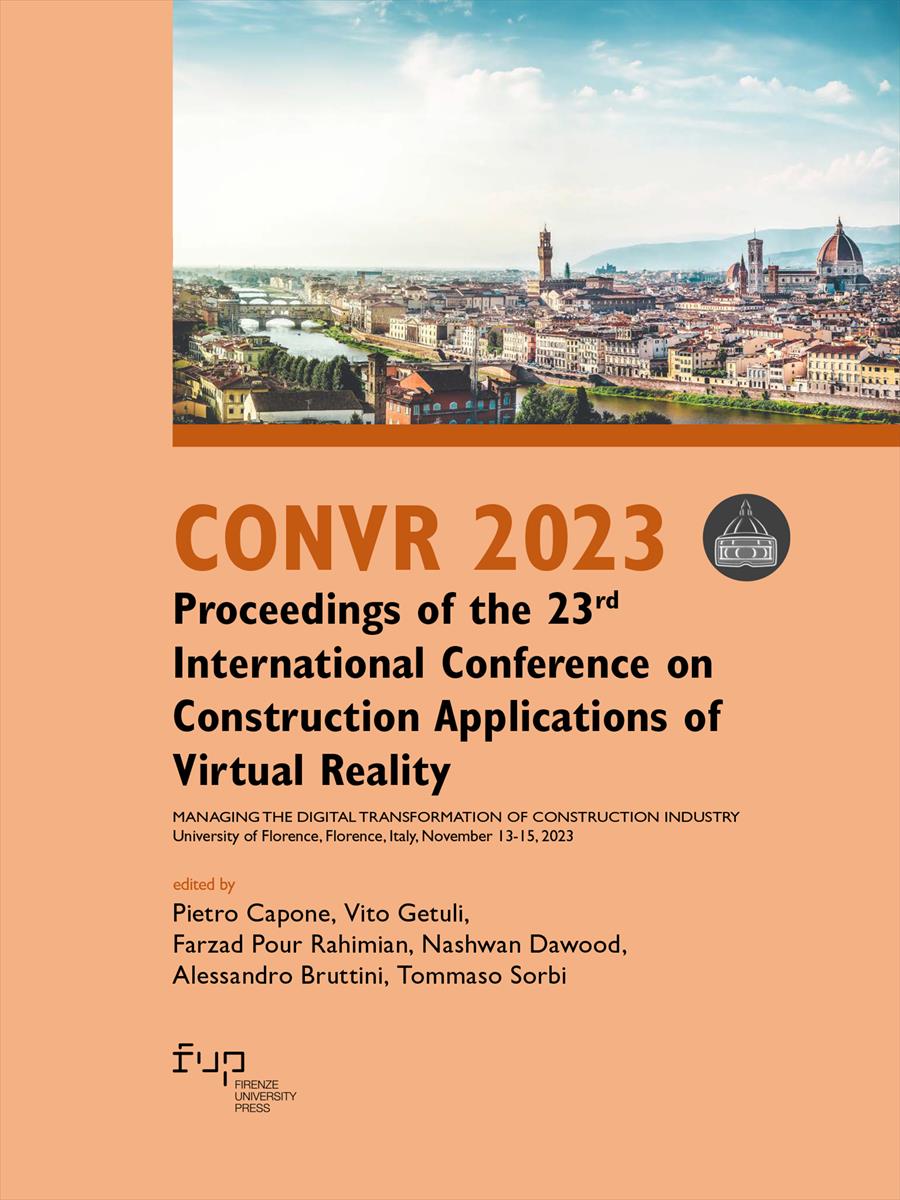- CONVR 2023 - Proceedings of the 23rd International Conference on Construction Applications of Virtual Reality
- A cura di Pietro Capone, Vito Getuli, Farzad Pour Rahimian, Nashwan Dawood, Alessandro Bruttini, Tommaso Sorbi
Digital Twins for Smart Decision Making in Asset Management
- Chady Elias
- Raja Issa
- © 2023 Author(s) |
- CC BY-NC 4.0
- DOI: 10.36253/979-12-215-0289-3.123
This study discusses the classification of Digital Twins (DTs) and their use in the Architecture, Engineering, Construction, and Operations (AECO) industry, the differences between building information modeling (BIM) and DT are emphasized and platforms for implementing DTs are compared. DTs are quickly gaining traction in the AECO industry because they create the ability to interact virtually with all physical smart devices in the built environment. The need for replicas goes all the way back to the 1960s, when NASA created physical replicas of spaceships and connected them to simulators to develop workshop solutions on the ground. DTs are simply building blocks of the metaverse that act as a real-time digital copy of a physical object. Based on data from the physical asset or system, the physical twin (PT), a DT unlocks value in supporting smart decision-making by combining artificial intelligence (AI) with the internet of things (IoT)
- Keywords:
- Digital Twins; Internet of Things; Artificial Intelligence; Asset Management,
University of Florida, United States
University of Florida, United States - ORCID: 0000-0001-5193-3802
- Adamenko, D., Kunnen, S., & Nagarajah, A. (2020a). Comparative Analysis of Platforms for Designing a Digital Twin. In: Ivanov, V., Trojanowska, J., Pavlenko, I., Zajac, & J., Peraković, D. (eds.), Advances in Design, Simulation and Manufacturing III. DSMIE 2020. Lecture Notes in Mechanical Engineering. Springer, Cham. DOI: 10.1007/978-3-030-50794-7_1
- American Institute of Architects (AIA) (2022). AIA Document E202TM-2022: BIM Exhibit for Sharing Models with Project Participants.
- Asare, K.A.B., Issa, R.R.A., Rui. L. & Anumba, C. (2021). “BIM for Facilities Management: Potential Legal Issues and Opportunities,” Journal of Legal Affairs and Dispute Resolution in Engineering and Construction, 2021, 13(4), DOI: 10.1061/(ASCE)LA.1943-4170.0000502.
- Attaran, A. & Celik, B. G. (2023). Digital Twin: Benefits, use cases, challenges, and opportunities, Decision Analytics Journal, 6, 100165, DOI: 10.1016/j.dajour.2023.100165
- Becerik-Gerber, B., F. Jazizadeh, N. Li, & G. Calis. 2012. “Application Areas and Data Requirements for BIM-Enabled Facilities Management.” Journal of Construction Engineering and Management 138 (3): 431–42. DOI: 10.1061/(ASCE)CO.1943-7862.0000433
- Brilakis, I., Pan, Y., Borrmann, A., Mayer, H.-G., Rhein, F., Vos, C., Pettinato, E., & Wagner, S. (2019). “Built Environment Digital Twining”. International Workshop on Built Environment Digital Twinning presented by TUM Institute for Advanced Study and Siemens AG. DOI: 10.17863/CAM.65445
- Delgado, J. M. D. and Oyedele, L. (2021). Digital Twins for the built environment: Learning from conceptual and process models in manufacturing. Advanced Engineering Informatics, 49, 101332. DOI: 10.1016/j.aei.2021.101332
- Greer, C., Burns, M., Wollman, D., and Griffor, E. (2019). Cyber-physical systems and Internet of Things. National Institute of Standards and Technology (NIST) Special Publication 1900-202. DOI: 10.6028/NIST.SP1900-202
- Khajavi, S.H.; Motlagh, N.H.; Jaribion, A.; Werner, L.C.; Holmstrom, J. (2019). Digital Twin: Vision, Benefits, Boundaries, and Creation for Buildings. IEEE Access, 7, 147406-147419.
- KPMG (2022). Insight report: Innovation & R&D in construction.
- Kritzinger, W., Karner, M., Traar, G., Henjes, J., and Sihn, W. (2018). Digital Twin in manufacturing: A categorical literature review and classification. IFAC-PapersOnLine, 51(11), 1016-1022. DOI: 10.1016/j.ifacol.2018.08.474
- Redelinghuys, A.J.H., Basson, A.H. & Kruger, K. (2020). A six-layer architecture for the digital twin: a manufacturing case study implementation. Journal of Intelligent Manufacturing, 31, 1383-1402. DOI: 10.1007/s10845-019-01516-6
- Salvador Palau, A., Dhada, M. H., & Parlikad, A. K. (2019). Multiagent system architectures for collaborative prognostics. Journal of Intelligent Manufacturing, 30(8), 2999–3013 DOI: 10.1007/s10845-019-01478-9
- Tao, F., Cheng, J., Qi, Q., Zhang, M., Zhang, H., and Sui, F. (2018). Digital twin-driven product design, manufacturing and service with big data. International Journal of Advanced Manufacturing Technology, 94(9-12), 3563–3576. DOI: 10.1007/s00170-017-0233-1
Informazioni sul capitolo
Titolo del capitolo
Digital Twins for Smart Decision Making in Asset Management
Autori
Chady Elias, Raja Issa
DOI
10.36253/979-12-215-0289-3.123
Opera sottoposta a peer review
Anno di pubblicazione
2023
Copyright
© 2023 Author(s)
Licenza d'uso
Licenza dei metadati
Informazioni bibliografiche
Titolo del libro
CONVR 2023 - Proceedings of the 23rd International Conference on Construction Applications of Virtual Reality
Sottotitolo del libro
Managing the Digital Transformation of Construction Industry
Curatori
Pietro Capone, Vito Getuli, Farzad Pour Rahimian, Nashwan Dawood, Alessandro Bruttini, Tommaso Sorbi
Opera sottoposta a peer review
Anno di pubblicazione
2023
Copyright
© 2023 Author(s)
Licenza d'uso
Licenza dei metadati
Editore
Firenze University Press
DOI
10.36253/979-12-215-0289-3
eISBN (pdf)
979-12-215-0289-3
eISBN (xml)
979-12-215-0257-2
Collana
Proceedings e report
ISSN della collana
2704-601X
e-ISSN della collana
2704-5846
